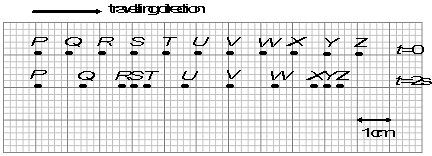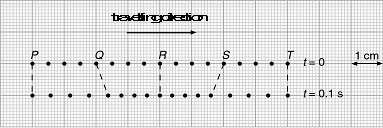
1.The waveforms at t = 0.5 s and t = 1.5 s are shown in the following figure.

What is the minimum possible frequency of the wave?
A 0.25 Hz
B 0.5 Hz
C 0.75 Hz
D 1 Hz
The answer is D
2. The following figure shows a longitudinal wave.

At t = 2 s, what are the directions of motions of Q and Y ?
|
Q |
Y |
A |
Towards the right |
Towards the right |
B |
Towards the left |
Towards the left |
C |
Towards the right |
Towards the left |
D |
Towards the left |
Towards the right |
The answer is D
3.
1st statement |
2nd statement |
When the end of a slinky string is shaken up and down, a transverse wave is produced. |
Particles in a transverse wave vibrate at right angles to the direction that the wave travels. |
The answer is D (1st statement is false, 2nd statement is true.)
4.A ship in the open sea swings up and down 4 times in 2 hour when a tsunami ( 海嘯 ) wave passes by. The distance between two successive crests of the wave is 100 km . Find the speed of the tsunami wave.
A 100 km h -1
B 200 km h -1
C 400 km h -1
D 800 km h -1
The answer is C
5. The following figure shows a longitudinal wave travelling in a medium at different time.

At t = 0.1 s, which particle(s) move(s) at the highest velocity?
A R
B Q and S
C Q , R and S
D P , R and T
The answer is D
6. In the following figure, a dipper, which is 5 cm in front of a barrier, produces a circular wave of wavelength 2 cm .
|
If constructive interference occurs at P , what is the possible distance between the dipper and P ?
A 10 cm
B 16 cm
C 24 cm
D 32 cm
The answer is C
7.In the following figure, two loudspeakers X and Y are connected to a signal generator, and a microphone is connected to a CRO.
|
When the microphone moves from P to Q , where P lies on the centre line between X and Y , the reading of the CRO varies as shown in the following figure.
|
If the frequency of the signal generator is set at 850 Hz, and the speed of sound is 340 m s –1 , what is the path difference between XQ and YQ ?
A 0.5 m
B 0.75 m
C 1 m
D 1.5 m
The answer is C
8.A student shots a video of a water wave. From the video, he uses a software to capture a series of pictures. He finds that the maximum capture rate is 150 pictures per minute if he wants the positions of the wavefronts remain changed in these pictures. If the wavelength observed is 12 cm , what is the speed of the water wave?
A 1.2 m s - 1
B 2 m s - 1
C 2.6 m s - 1
D 3.6 m s - 1
The answer is D
9. In the following figure, two plane mirrors at right angles face each other. An object is place at O . Multiple images are thus formed by the mirrors. Which of the images CANNOT be observed by the observer?
|
A I 2 only
B I 3 only
C I 2 and I 3 only
D I 3 and I 4 only
The answer is D
10.A light ray travels from medium I to medium IV, as shown in the following figure. Arrange the refractive indices of the media in ascending order.
|
A IV < II < I < III
B III < IV < II < I
C IV < II < III < I
D III < I < IV < II
The answer is A
11.If F and F ' are the foci of a convex lens, which of the following ray diagrams is/are INCORRECT?
(1) |
|
(2) |
|
(3) |
|
||
A (1) only
B (2) only
C (1) and (3) only
D (2) and (3) only
The answer is D
12. In the following diagram, the magnification of the real image is 1.5. What is the focal length of the convex lens?
|
A 4 cm
B 6 cm
C 8 cm
D 10 cm
The answer is D